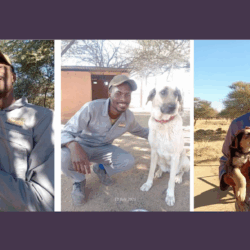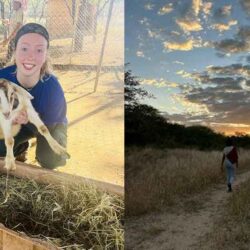Our journey at CCF: Conservation and Collaboration
-

- by Courtney Bloxham and Alice Kis June 12, 2024

We are two students from the Environmental and Wildlife Management at Vanier College, Montreal. We are in our third and final year, about to graduate from our program, which requires students to do an internship so that we can integrate the various skills learned throughout our program in a working environment. When we were presented with the opportunity to come to Namibia and get to discover a whole new ecosystem and culture, we were ecstatic, and immediately seized the opportunity, finally setting foot at CCF on March 18.
During the beginning of our internship, we found ourselves overlapping our internship with the veterinary technicians Kaylen and Charlotte from Vanier College. As well, nearing the end of our internship, more veterinary technicians from Vanier College arrived, Anthony and Alexandra. Although our internships did not work side by side, it was comforting knowing that even in an unfamiliar environment, having familiar faces provided us with a sense of support, allowing us to truly enjoy our experience at CCF.

General Work
Once a week we would have a general day where our tasks varied. This included working in the creamery, where we made ice cream and feta cheese from fresh goat milk. We also aided with animal husbandry, interacting closely with cheetahs to ensure their well-being and habitat enrichment. Our responsibilities extended to the kraal, where we assisted in vaccinating the livestock, playing a crucial role in maintaining the health of the herd. Additionally, we cared for the guardian livestock dogs, ensuring they were well-fed and healthy. In the garden, we watered and cultivated a variety of vegetables. These tasks gave us an experience that we will never forget.

Ecology Team
With the ecology team, we helped collect baseline data for the collaborative project between CCF and Vanier College that aims to study the impacts of bush encroachment on biodiversity over a 5-year period. Within CCF’s reserve, the main group we surveyed were dung and ground beetles. Each plot was surveyed from Monday to Friday, after which we would move onto the next plot. To survey the beetles, pitfall traps, which are essentially plastic cups in a jar, covered by a lid that is slightly raised off the ground by the aid of nails, were placed in the ground with 10 metres separating one another. Each plot had three transects, each of them having 11 pitfall traps, and they would alternate between being baited with fresh cow poop, to attract the dung beetles, and being empty, for the ground beetles, although they would occasionally be found chilling with the dung beetles covered in poop. In the morning, we would walk along the transects and check the traps for any beetles, which would be counted and identified. We go to put our identification skills to test, alongside trying to identify the unknowns, which proved to be more difficult, as some did not have any distinguishing characteristics
Alongside beetle sampling, we also took part in soil sampling. There is little research done on the soil in southern Africa, as it is mostly arid, but CCF aims to change that by looking at how the removal of vegetation might impact the physical and chemical composition of soil. The sampling was done in the same six plots, and each plot had a total of four subplots, with a tree being selected in each. At each tree, a total of eight holes were dug, four under the canopy, and four on the outside. The holes were 30cm deep, and samples were taken from a depth of 30-15cm, and then from 0-15cm. Samples to look at microorganisms, and to look at the bulk density were also collected. After our hard work, a whopping total of 192 holes were dug, and 192 bags of soil were collected
Alongside sampling beetles and soil, we also got to service the camera traps located within the reserve once a week, which is part of CCF’s long term monitoring study. We would drive up to the locations, and change the SD cards, as well as the batteries if they were low. Once back in the office, we would sort through the images, and get to see the animals that come out when humans are not there. We also got to see some awesome images, such as a brown hyena carrying a kill, and baboons curiously inspecting the camera! We also took part in the Big Field game count, where we would drive on the roads and identify any mammal/big bird we would see. We would also count, age and sex them, which aids in helping CCF monitor the game species they have within their reserve.

Our experience
Our experience at CCF was amazing and unforgettable. Being able to see and work alongside wildlife was inspiring. We built life-long friendships with the fellow interns, sharing unforgettable memories. Immersing ourselves in the cultures of Namibia provided us with a deeper connection with the people and animals. This experience at CCF has impacted us both personally and for our future careers, we are forever thankful for this unforgettable experience.
"Cheetah Tracks" Newsletter Sign-Up
Stay updated on the activities of Cheetah Conservation Fund in Canada, Namibia and Somaliland. We send semi-annual newsletters and info about special events and initiatives. We will not share your email address with any other organization.
Related Reading
-
July 22, 2025
From UNAM Graduate to Livestock Intern in the Field. -
June 9, 2025
Vanier Student’s Internship Experience at CCF



